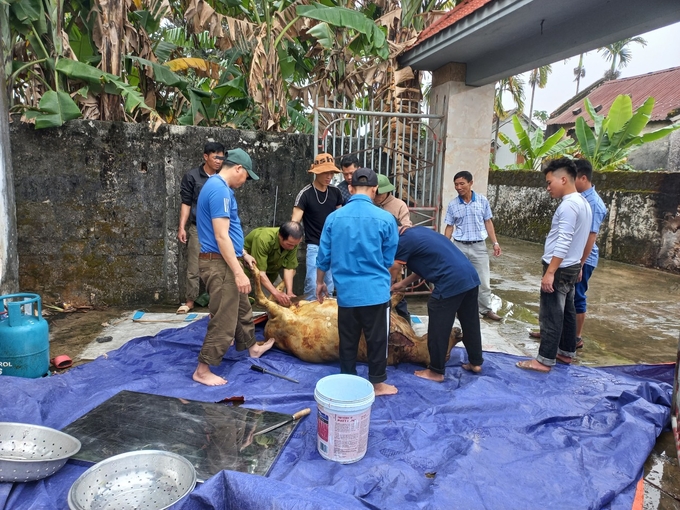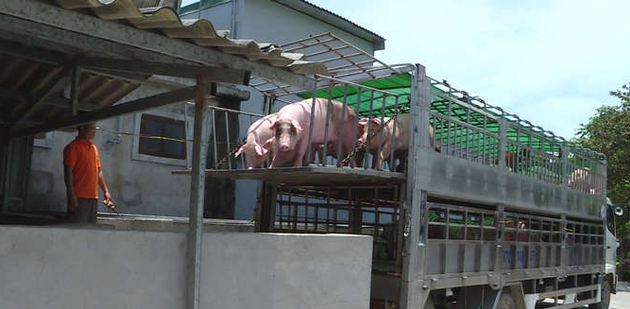According to Nghe An Provincial Livestock and Veterinary Medicine Department, the province slaughters an average of over 25,000 cattle and poultry every day, including over 200 buffalo and cows; more than 4,000 pigs; almost 20,000 poultry and more than 200 goats.
Of the above slaughter animals, fewer than 7,000 were slaughtered under control. The number of small slaughterhouses is too large and scattered, and the veterinary staff is too thin, so there are many difficulties in controlling slaughter.

A concentrated slaughterhouse in Long Xa Township, Hung Nguyen District has had to shut down due to inefficiencies. Picture: Phu Huong.
Relaxation of battle management
There are currently 822 beef and poultry slaughterhouses in the province. According to the old regulations, there are still 41 standardized slaughterhouses (with trade licences, certificates of veterinary hygiene conditions and veterinary staff to supervise the slaughter).
But according to the regulations in QCVN 150: 2017/BNNPTNT (Circular No. 13/2007/TT-BNNPTNT of June 20, 2017) of the Ministry of Agriculture and Rural Development on “National Technical Regulation on Veterinary Sanitary Requirements for the Slaughter of Concentrated Animals”. In these plants, there is no uniform slaughterhouse for concentrated animals in the entire province.
According to Mr. Ngo Duc Quynh, deputy director of Nghe An Province Subdivision of Animal Husbandry and Veterinary Medicine, concentrated animal slaughterhouses across the province do not meet the standards as they do not meet the requirements of location (about 200m from residential areas, permitting authority… In particular, only 170 of the 822 animal slaughterhouses currently have a business registration.
The construction, development and maintenance of central slaughterhouses is difficult for a number of reasons. Since 2012, the province has developed a plan for slaughterhouses with supporting mechanisms and guidelines. However, the implementation results do not meet the requirements. Many farms have invested billions of dongs but have only operated for a short time because the number of cattle sent for slaughter is too small and the cost is insufficient to keep them running, typically concentrated slaughterhouses. In Long Xa township in Hung Nguyen district, operations had to be suspended due to inefficiency…

Veterinary hygiene control in Nghe An is generally quite lax. Picture: ST.
Due to lax slaughter management, many slaughterhouses can operate with impunity. With good management and control of the slaughterhouses, the meat products on the market are provided with the quality mark of a veterinary control. In fact, most animals in today’s meat trade market of all types of animals, which are largely pork, do not carry any quarantine authority markings whatsoever.
In Vinh City, a large urban center, it is difficult to find out where meat is veterinary quarantined due to investigations into many stalls selling pork and buffalo meat. According to Mr. Nguyen Tien Duc, director of Vinh City Agricultural Service Center, the city currently has three concentrated slaughterhouses licensed to comply with veterinary sanitation conditions in cattle slaughter. However, all three of these farms only slaughtered about 40 pigs, buffalo and cows per night.
There are now too many slaughterhouses supplying dozens of tons of pork, beef and poultry. Typically, there are more than 40 slaughterhouses in Nghi Phu Municipality, most of them in the province, but they are not subject to quarantine. The meat from these slaughterhouses is widely sold in markets and shacks around the city.
Wondering why the slaughterhouses are getting out of hand here? The head of Nghi Phu municipality (Vinh city) said that the quarantine of animal slaughterhouses is the task of the city’s agricultural service center and the municipality’s veterinary staff are only doing propaganda. When asked at the Municipal Agricultural Service Center, the representative of the center replied that he had not been assigned a task.
Many hidden dangers
In fact, animal slaughter in Nghe An province at present has many unstable risks for consumer health, livestock and poultry disease prevention, and also animal disease consequences. It causes pollution…

Spontaneous and small-scale slaughterhouses are still popular in Nghe An and are not strictly controlled. Picture: ST.
Cannot be subjective in livestock and poultry diseases. In the past year 2022 alone, the province experienced 166 outbreaks of African swine fever in 18/21 counties, cities and towns, the number of dead pigs to be destroyed was over 6,000, and dozens of localities had cattle and buffalo with them Dermatitis infected. The knot cannot be healed. For example, in Yen Thanh district, in 2022, African swine fever occurred in 552 households, 137 hamlets and 33 communes. The number of pigs to be destroyed is 1,743, with a total weight of 84,884 kg…
Meanwhile, the management of centralized slaughterhouses still has many shortcomings and limitations. Since then, the situation of slaughterhouses causing environmental pollution and food safety and hygiene remains open. Typically, Nam Nghia Township (Nam Dan District) is the place with the highest number of cattle, buffalo and pig herds in the district. There is a central slaughterhouse that slaughters an average of more than 100 buffalo, cows and pigs per day, but the slaughter management is too lax.
Nam Nghia Commune People’s Committee Chairman Tran Xuan Han admitted that the quarantine at the Commune’s slaughterhouses is still insufficient.
In fact, the food safety of animal products has not been regularly monitored and not even sampled for testing, posing a potential risk of disease outbreaks. In particular, a number of slaughterhouses have signed a commitment to comply well with the veterinary hygiene criteria groups and ensure food safety, but have still made mistakes, e.g. B. in the collection and maintenance of records. , books on information about the origin of imported animals and the animal health status before slaughter… have not been seriously and properly implemented.

It is difficult for centralized slaughterhouses to keep operating as there are still small slaughterhouses. Picture: THNA.
The system of garbage collection and environmental hygiene are not guaranteed, the slaughter takes place mainly on the ground, there is no place where the slaughter is hanging. Regular health checks for owners and workers directly involved in slaughter are almost never carried out.
Need a strict management solution
In order to orderly slaughter animals, ensure food hygiene and safety, and prevent epidemics for the community, livestock and poultry, the People’s Committee of Nghe An Province issued Decision No. 5008/2012 approving the Planning for concentrated cattle and poultry slaughterhouses in the province by 2020, after which the goal will be 120 concentrated slaughterhouses by 2020 to ensure food hygiene and safety. , environmental hygiene and livestock and poultry epidemic prevention… But so far there are only 41 concentrated animal slaughterhouses in the province (according to the old regulations) and according to the regulations issued in 2017 by the Ministry of Agriculture and Rural Development. – In rural areas there is no central slaughterhouse that meets the required standards.
The current state of lax management of concentrated animal slaughterhouses and some spontaneous small slaughterhouses cannot last forever as it will have many unpredictable consequences. Recently, the People’s Committee of Nghe An Province issued Guideline No. 02/CT-UBND dated February 9, 2023 on Strengthening Animal Slaughter Management and Control, and Ensuring Disease and Food Safety. Products.

As a province with a high demand for animal products, Nghe An currently does not have a centralized slaughterhouse that meets the standards. Picture: THNA.
Under the above policy, the Provincial People’s Committee assigned the Ministry of Agriculture and Rural Development and local leaders to review and involve them in the planning of concentrated slaughterhouses. By assigning veterinary workers to fight the disease, communities are developing a roadmap to convert small animal slaughterhouses into centralized slaughterhouses under the control of local authorities and agencies. veterinary office.
In addition to the contents of the policy of the Nghe An Provincial People’s Committee, it is understood that the province should have the following additional contents:
The first: The provincial people’s committee must clearly assign the specific responsibilities of local authorities and veterinary services in coordinating the management of central slaughterhouses and small slaughterhouses. Before practicing in accordance with the law, it is necessary not to allow the past to affect the slaughterhouses, harming consumer health, polluting the environment and spreading diseases…
Monday: Violations of the law in business, trade and slaughtering of animals without a business license, without invoices and receipts, without guaranteeing the hygiene of food and meat products must be severely punished. Animals traded on the market do not bear veterinary quarantine marks… and slaughterhouses do not provide a hygienic environment, which leads to pollution.
Tuesday: The Department of Agriculture and Rural Development in general, and the Subdivision of Animal Husbandry and Veterinary Medicine in particular, should coordinate with the people’s committees of counties, cities and townships and people’s committees of counties, counties and townships where there are slaughterhouses to organize training and to organize Guide for slaughterhouse owners and direct slaughterers to master both theory and practice in the application of slaughtering procedures, veterinary hygiene, food safety and hygiene and ensuring a respectful environment…

